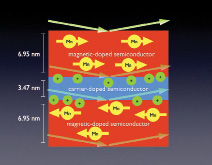Solving the ‘Silicon Crisis’ With Quantum Computing

Randy Hoffner
If you are a recent reader of this column or other sources of electronics news, you know that we are approaching a “silicon crisis.” Moore’s Law, the regular doubling of the number of transistors that can be fabricated on a silicon chip of a given size, has nearly run its course for reasons that we have covered previously.
We saw that one way to postpone this day of reckoning might be the use of carbon nanotube field effect transistors or CNFETS. But this would only be a postponement. Tomorrow’s real breakthrough computing technologies are currently being developed by one of the oldest computer companies in the United States.
ON THE RESEARCH FRONT
A recent development emerging from IBM Research is nothing short of startling: digital ones and zeros have been stored and retrieved from an array of just 12 iron atoms implanted in a special type of magnetic material.
A group at IBM’s Almaden Research Center in Silicon Valley created a unit of magnetic storage by arranging two rows of six iron atoms each on a substrate of copper nitrite atoms, which are clustered quite tightly together furnishing “magnetic insulation” from other such iron clusters because they are antiferromagnetic.
When ferromagnetic materials like iron and nickel are magnetized, the magnetic moments of the individual atoms, which are defined by the spins of their electrons, are magnetically aligned.
That is, the spins of the electrons of a given atom are aligned with like electron spins of neighboring atoms, so their north poles all point in one direction and their south poles all point in the opposite direction. The net effect is that when a piece of ferromagnetic material is magnetized, it has a north pole and a south pole, causing it to display magnetic properties.
In antiferromagnetic materials, the spins of individual atoms are aligned with neighbors having opposite spins. The result is that the north and south poles of the individual atoms effectively cancel each other out, rather than reinforcing each other. Their mutual polar attractions cause them to be tightly compacted on the atomic level, and a piece of antiferromagnetic material does not display magnetic properties.

Researchers working at NIST have confirmed that thin magnetic layers (red) of a semiconductor separated by a nonmagnetic layer (blue) can exhibit a coveted phenomenon known as ‘antiferromagnetic coupling,’ in which manganese (Mn) atoms in successive magnetic layers spontaneously orient their magnetization in opposite directions. This discovery, made by scattering neutrons (arrows) from the material, raises the prospects of ‘spintronic logic circuits’ that could both store and process data. This property prevents individual ferromagnetic clusters from interfering with each other, facilitating “extra-dense” storage.
In the IBM research, one bit of data was stored in just 12 iron atoms, as opposed to a contemporary hard drive, which stores a single bit of data in about a million atoms.
The implications of this are apparent, but the process is a long way from being commercialized. In the IBM experiment, the storage medium was held close to absolute zero; and a scanning, tunneling microscope was used to manually configure the atoms to store the data bits. The experimenters have said that the same result could be achieved at room temperature using about 150 iron atoms. IBM claims that this harbors the potential for storage 100 times denser than today’s hard disks.
ALMOST INCOMPREHENSIBLE
Perhaps the most scientifically interesting aspect of this work is the fact that even smaller groups of atoms begin to exhibit quantum mechanical behavior, simultaneously existing in both spin states, so they simultaneously represent both ones and zeros.
This has been analogized to a loop in which a given current flows counterclockwise, while another current simultaneously flows clockwise. Atoms such as these may be assembled into so-called quantum bits or qubits, opening the door to the slightly bizarre world of quantum computing.
Like most things dealing with quantum mechanics, this is almost incomprehensible.
To quote Niels Bohr, “If anybody says he can think about quantum physics without getting giddy, that only shows he has not understood the first thing about them.”
IBM experimenters are making superconducting qubits, in a so-called “delusion refrigerator,” which can achieve temperatures of 15–20 milliKelvins; that is, 0.015–0.020 degree Celsius above absolute zero. At this temperature, a qubit starts at its quantum ground state and can be kept “pure” for a longer time before it degenerates into a single-state bit.
The goal is to produce a “logical qubit,” i.e., one that never degenerates. To repeat, a qubit is a bit that exists in both logical states, one and zero, simultaneously. Remember Niels Bohr.
This is highly experimental, but experimenters feel that a stable quantum computer may be realized within 10 or 15 years, although it sounds like science fiction, if not outright fantasy, today.
To give an idea of what this might mean, a 250-qubit quantum computer could hold more bits than there are particles in the universe. Another example is factoring a 1000-digit decimal number.
This might take existing computers the age of the universe to perform, but a quantum computer of appropriate size might do this task in an hour. This would, of course, render most current encryption schemes ineffective.
Nanoelectronic storage and quantum computing are just laboratory experiments now, but things are happening quickly, and sooner or later they will be technology we can use.
So as we stand at the historical place where we can see the end of Moore’s Law just down the road, we also see some very exciting new breakthroughs in electronics out there.
Fasten your seat belts; it’s going to be a wild ride!
Randy Hoffner is a veteran of the big three TV networks. He can be reached through TV Technology.
The professional video industry's #1 source for news, trends and product and tech information. Sign up below.

